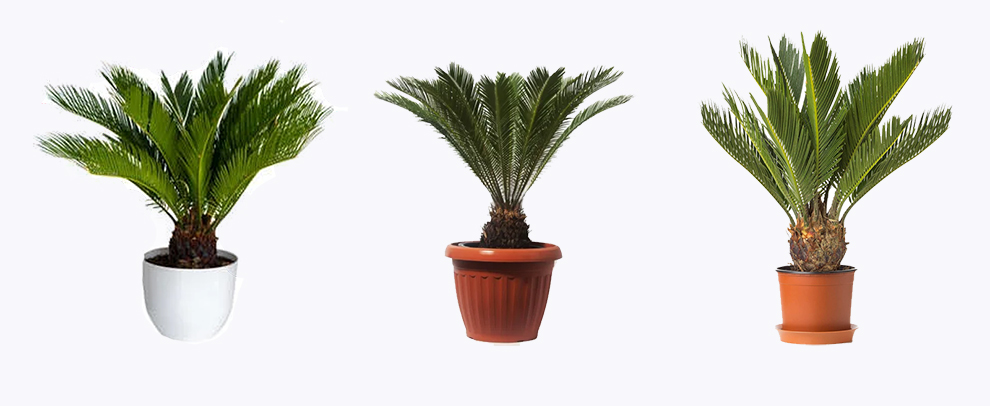Sago Palm Varieties: All About Its Different Types

Botanically known as the Cycas revoluta, the Sago palm has long green fronds, looks like a tropical plant, and resembles the other palms. Native to Southern China and Japan, it is not a palm tree. It is a Cycad, the hardiest and the oldest plant group in history.
It is a slow-growing plant that yields nuts and no fruits or flowers. They are hugely popular as bonsais and houseplants, especially in places with a cooler temperature.
As they are drought-tolerant, they are a good pick for people who are not regular with the care and watering. But the plant has cycasin in them, making it toxic for both pets and people if accidentally consumed.
Jump To
- Different Kinds of Sago Palms
- Sago Palm Seeds: What Is Special About Them?
- How Fast Does A Sago Palm Grow?
- How To Care For A Sago Palm?
- Sago Palm Toxicity: What Part Of The Sago Palm Is Poisonous?
- FAQs
Hence, it must be kept away from the reach of children and pets. There are different types of sago palms. In this guide below, we discuss the most prevalent ones.
How Many Different Kinds of Sago Palms Are There?

1. Queen Sago Palm
Speaking about the sago palm tree types, first, we have Queen Sago Palm. An evergreen shrub, Queen Sago is a magnificent cycad renowned for its palm-like features. Its resemblance to a palm gives it a tropical appeal and adds value to any space.
Native to the Old-World Tropics, they have unbranched stems and a crown on top. Known to pre-date even the dinosaurs, this is the more graceful and fuller cycad, even more attractive than King Sago.
Also known as the Fern Palm, the female and male flowers yield on different plants. African Queen Sago is one of its most magnificent variants, and like any other Sago variety, it is also slow-growing.
These sago palms usually grow to a small or a mid-size (usually between three to five meters) with dark green pinnate leaves and a solitary trunk. These sago palm varieties have narrow leaves that bend downwards. Newer leaves are lighter in hue and add an appealing contrast for the onlookers.
Typically, the light conditions for the different types of sago palms are more or less the same. Queen Sago thrives in partial to full sunlight and has regular water requirements. You can plant it in rocky-sandy acidic soil with abundant organic matter.
2. King Sago Palm
Another one of the most magnificent sago palm is the King Sago Palm. These sago palm tree types have a palm-like resemblance.
Moreover, amongst the different varieties of Sago, the King Sago Palms are more commonly seen as houseplants.
Native to Japan, these living fossils have been around since the Mesozoic era. It is a slow-growing, compact shrub, which grows interestingly well in a decent, sturdy container. However, they can show an incredible growth rate if exposed to the correct soil, sun, and water conditions.
They need well-drained and rich, moist soil with an organic mix. It is best to keep the palm away from wet and mucky soil. Partial to full sun is suitable for the plant to thrive.
Also known as Japanese Sago, these sago palm varieties need minimal care but can add a wonderful accent to a patio, living space, outdoor garden, or any other environment.
Their beauty is maximized during the late spring when new leaves appear on the plant. But, if you reside in cooler zones or during the winters, it is best to bring the plant indoors to avoid frosting.
To distinguish the King Sago Palms from the other types of sago palms, look for their symmetrical dark green leaves and small trunk.
3. True Sago Palm
Botanically known as the Metroxylon Sagu, these are the third kind of sago palm species. It thrives in a swampy tropical lowland conditions and can grow to about 80”. Moreover, it also has one of the most enormous flowers in the plant kingdom, about 25” tall from the palm’s top. Its fruits are also massive.
Compared to the other types of sago, this one needs consistently moist soil. Hence, you must not let it dry between two watering. Further, its moisture requirements are high. These sago palm tree types are perfect for water gardens and bogs. In addition, the shrub needs full sun.
Unlike the other sago palm varieties, the True Palm is actually a palm. It is a member of the Arecaceae family, and you can find this shrub across tropical Southeastern Asia.
These types of sago palms are a prevalent source of edible starch. There is a massive amount of starch in the palm’s trunk, and it can be harvested from the trunk by grinding the pitch and finally extracting the starch and water. The starch extracted from these palms is used for food and non-food things.
In Papua New Guinea and Eastern Indonesia, it is a staple food. The plant is tropical in its needs and can form a forest of a huge palm in only a matter of time. New leaves are astonishingly pretty red.
Sago Palm Seeds: What Is Special About Them?
The fruits of the female sago palm varieties have orange-red hued seeds in them. The germination of the seeds depends on the seed itself, which can be either female or male.
For harvesting a quality seed, you need both mature female and male seeds. Upon germination, these orange seeds grow up as magnificent garden plants, the Sago Palm. The plants are grown from pups or seedlings, readily available in the nursery. You can also use the seeds to grow the plants.
However, the germination process is time-consuming and may take a few months. Also, if you intend to grow different types of sago palms from the seeds, please wear gloves. We say so because the seeds have toxins in them.
How Fast Does A Sago Palm Grow?
Typically, all sago species of sago palms are very slow-growing. If you have an indoor palm that is a sago of about twenty-four months, you can easily accommodate it in a five-inch pot. As the roots are pot-bound, the growth rate is not high.
On the other hand, the mature outdoor sago palms can take about five decades to grow 10-12 feet tall.
How To Care For Sago Palm Tree Types?
Almost all sago palm varieties enjoy bright and warm weather. Here is a guideline to help you care for your Sago Palm.
Humidity
Sago palms love humid environments. For this, you can regularly mist your palm. However, ensure that there is no sitting water in the pot. It can result in root rotting.
Light
Sago palms love bright sunlight but can survive even low-light conditions. For the plant to thrive, one must never place them under the direct sun as the harsh sunlight may burn the leaves.
Conversely, excessive shade is not suitable for the plant as it can inhibit its growth. You can place your indoor houseplant outside during the morning and evening to cater to their light requirements.
Water
All different types of sago palms are pretty forgiving and drought-tolerant. However, they do like moist soil. So, try to water them anytime the soil feels dry, but they hate too much water.
Hence, you must touch the soil and assess it before watering. During the colder months, the plant’s growth is stalled. Herein, you can reduce your watering frequency.
Pot
Sago palms need a pot that has several drainage holes to ensure that there is no sitting water. Home planters can use the terra cotta porous pots as the excess moisture from the soil can quickly evaporate from them.
Soil
All sago palm varieties enjoy sandy soil with excellent drainage. Even though the soil should be moist, it should not be soggy. Further, soil with acidic-neutral pH is suitable. The organic matter content in the soil should be high. You can include a dedicated potting mix for cactus or palms for the shrubs to thrive.
Fertilizer
All types of Sago palms need a fertilizer regularly to maintain good health and for the palm to bloom. However, they are slow-growing, and container sago can take a long time to bloom.
Spring is the blooming season, wherein you need to fertilize every month. You can use an 18 (Nitrogen) – 8 (Phosphorous) – 18 (Potassium) ratio liquid fertilizer. However, when using the fertilizer, please follow the package instructions.
Temperature
Ideally, sago palm varieties love the warm, bright weather, but brief cold weather is also manageable. But, if the cold weather continues, it can result in frosting. Frosting may hamper and even kill the plant. Hence, when the temperature goes below 23 degrees Fahrenheit, you must bring the plant indoors.
Sago Palm Toxicity: What Part Of The Sago Palm Is Poisonous?
Unfortunately, all the parts in a sago palm are poisonous. However, the seeds or the nuts are the worst when it comes to toxicity. These must be kept away from the reach of pets and children, as they are poisonous to both. Ingestion of the seeds can result in severe side effects.
Types of Sago Palms & The Most Common Queries
Ques 1. Are sago palms true palms?
Ans. As stated earlier, sago palms are not true palms. However, they have a tropical, palm-like resemblance, hence, the name.
Ques 2. Is there a miniature sago palm?
Ans. Yes, you can find a miniature bonsai sago palm. There are also specialized techniques to ensure the sago remains a miniature palm.
Ques 3. How can you tell the difference between a male and a female sago palm?
Ans. The structure of the male sago palms appears like a cone because of its elongated shape. On the other hand, the female sago palms have a dome-shaped, large cone and yield orangish-red seeds.
Ques 4. How tall does a sago palm get?
Ans. A mature sago palm will be between 3 to 10 feet tall.
Ques 5. What is growing in the middle of my sago palm?
Ans. In the male sago palms, you will see elongated slender palms that yield pollen in the middle. These pollens help in female sago palm fertilization. The cone will be there only for a week or two, after which it can be removed or cut off from the plant.
Ques 6. Do sago palm bear fruits?
Ans. No, the sago palm tree types do not have fruits or flowers. In the female sago plant, the circular structure conceals the seeds. In males, the elongated structure has pollen in them.
Ques 7. What do you do with sago palms after freezing?
Ans. Sago palms are tolerant plants and can survive in temperatures as low as 15 degrees. But, continued cold exposure or temperature dropping to 23 degrees can cause freezing.
After freezing, some sago palms can turn brown or yellow. Such leaves must be pruned from the plant. But, if upon closer look around the base, you find green coloration, it means that with plant, on the whole, can recover with proper care and temperature conditions. You can bring the plant indoors and give it the necessary care and nourishment.
Also, if the leaf crown and the trunk are hardwood, the plant will recover. But, unfortunately, if it has become soft, you cannot undo the damage.
Ques 8. Will sago palm leaves grow back?
Ans. All sago palm varieties have leaves that grow from the tip of the trunk when the plant is young. Healthy sago will yield large side branches after four to five decades, and new leaves will show from the growing tips on the main or the side branch tips. If fertilized well, the leaves will grow back.
